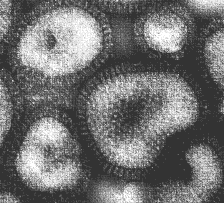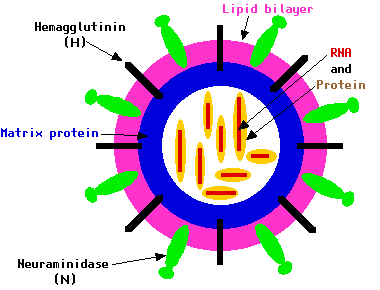
| Index to this page |
Influenza is a viral infection of the lungs characterized by fever, cough, and severe muscle aches. In the elderly and infirm, it is a major cause of disability and death (often as a result of secondary infection of the lungs by bacteria). Even in the young and healthy, influenza produces a prostrating disease of a few days duration and one not soon forgotten.
Influenza is notNo one at the time even knew what disease agent was causing the pandemic. Not until 1930 (in pigs) and 1933 (in humans) was it established that influenza is caused by a virus.

This electron micrograph (courtesy of Dr. K. G. Murti) shows several influenza virus particles (at a magnification of about 284,000x). The surface projections are molecules of hemagglutinin and neuraminidase (see below).
There are three types of influenza:Common but seldom causes disease symptoms
Often causes sporadic outbreaks of illness, especially in residential communities like nursing homes.
Responsible for regular outbreaks, including the one of 1918. Influenza A viruses also infect domestic animals (pigs, horses, chickens, ducks) and some wild birds.
 The influenza A virion is
The influenza A virion is

The result is a viral pneumonia. It usually does not kill the patient (the 1918 pandemic was an exception; some victims died within hours) but does expose the lungs to infection by various bacterial invaders that can be lethal. Before the discovery of the flu virus, the bacterium Hemophilus influenzae was so often associated with the disease that it gave it its name.
(The pandemic of 1957 probably made more people sick than the one of 1918. But the availability of antibiotics to treat the secondary infections, that are the usual cause of death, resulted in a much lower death rate.)
The hemagglutinin of the 1918 flu virus was H1, its neuraminidase was N1, so it is designated as an H1N1 "subtype". Here are some others.
| Date | Strain | Subtype | Notes |
|---|---|---|---|
| 1918 | H1N1 | pandemic of "Spanish" flu | |
| 1957 | A/Singapore/57 | H2N2 | pandemic of "Asian" flu |
| 1962 | A/Japan/62 | H2N2 | epidemic |
| 1964 | A/Taiwan/64 | H2N2 | epidemic |
| 1968 | A/Aichi/68 | H3N2 | pandemic of "Hong Kong" flu |
| 1976 | A/New Jersey/76 | H1N1 | swine flu in recruits |
These data suggest that flu pandemics occur when the virus acquires a new hemagglutinin and/or neuraminidase. For this reason, when an H1N1 virus appeared in a few recruits at Fort Dix in New Jersey in 1976, it triggered a massive immunization program (which turned out not to be needed). However, another H1N1 virus appeared the following year causing the "Russian" flu. Because most people born before the Asian flu pandemic of 1957 had been exposed to the H1N1 viruses circulating before, the Russian flu primarily affected children and young adults.
Where do the new H or N molecules come from?
Birds appear to be the source. Both the H2 that appeared in 1957 and the H3 that appeared in 1968 came from influenza viruses circulating in birds.
The encoding of H and N by separate RNA molecules probably facilitates the reassortment of these genes in animals simultaneously infected by two different subtypes. For example, H3N1 virus has been recovered from pigs simultaneously infected with swine flu virus (H1N1) and the Hong King virus (H3N2). Probably reassortment can also occur in humans with dual infections.
Missense mutations in the hemagglutinin (H) gene.
Flu infections create a strong antibody response. After a pandemic or major epidemic, most people will be immune to the virus strain that caused it. The flu virus has two options:The gradual accumulation of new epitopes on the H (and N) molecules of flu viruses is called antigenic drift. Spontaneous mutations in the H (or N) gene give their owners a selective advantage as the host population becomes increasingly immune to the earlier strains.
Although a case of the flu elicits a strong immune response against the strain that caused it, the speed with which new strains arise by antigenic drift soon leaves one susceptible to a new infection. Immunization with flu vaccines has proved moderately helpful in reducing the size and severity of new epidemics.
Some vaccines incorporate inactivated virus particles; others use the purified hemagglutinin. Both types incorporate antigens from the three major strains in circulation, currently:Because of antigenic drift, the strains used must be changed periodically as new strains emerge that are no longer controlled by people's residual immunity.
| Season | H1N1 | H3N2 | Type B |
|---|---|---|---|
| 86–87 | A/Chile/83* | A/Mississippi/85 | B/Ann Arbor/86 |
| 87–88 | A/Taiwan/86 | A/Leningrad/86 | B/Ann Arbor/86 |
| 88–89 | A/Taiwan/86 | A/Sichuan/87 | B/Victoria/87 |
| 89–90 | A/Taiwan/86 | A/Shanghai/87 | B/Yamagata/88 |
| 90–91 | A/Taiwan/86 | A/Shanghai/89 | B/Yamagata/88 |
| 91–92 | A/Taiwan/86 | A/Beijing/89 | B/Panama/90 |
| 92–93 | A/Texas/91 | A/Beijing/89 | B/Panama/90 |
| 93–94 | unchanged | unchanged | unchanged |
| 94–95 | A/Texas/91 | A/Shandong/93 | B/Panama/90 |
| 95–96 | A/Texas/91 | A/Johannesburg/94 | B/Harbin/94 |
| 96–97 | A/Texas/91 | A/Nanchang/95 | B/Harbin/94 |
| 97–98 | A/Johannesburg/96 | A/Nanchang/95 | B/Harbin/94 |
| 98–99 | A/Beijing/95 | A/Sydney/97 | B/Beijing/93 |
| 99–00 | A/Beijing/95 | A/Sydney/97 | B/Yamanashi/98 |
| 00–01 | A/New Caledonia/99 | A/Panama/99 | B/Yamanashi/98 |
| 01–02 | A/New Caledonia/99 | A/Panama/99 | B/Victoria/00 or similar |
| 02–03 | A/New Caledonia/99 | A/Moscow/99 | B/Hong Kong/2001 |
| 03–04 | A/New Caledonia/99 | A/Moscow/99 | B/Hong Kong/2001 |
| 04–05 | A/New Caledonia/99 | A/Fujian/2002 | B/Shanghai/2002 |
| 05–06 | A/New Caledonia/99 | A/California/2004 | B/Shanghai/2002 |
On 17 June 2003, the U. S. Food and Drug Administration (FDA) approved FluMist® – a live-virus vaccine that is given as a spray up the nose.
The viruses have been weakened so that they do not cause illness, but are able to replicate in the relatively cool tissues of the nasopharynx where they can induce an immune response. Presumably this is tilted towards IgA production, a better defense against infection by inhaled viruses than blood-borne IgG antibodies.
All three currently-circulating strains of flu (H1N1, H3N2, and B) are included. As new strains appear, they can be substituted.
At present, this new vaccine is not approved for children younger than five (who might love to avoid a needle) and adults over 50. People with immunodeficiency (e.g., AIDS) should also be cautious about taking it.
Antibiotics are of absolutely no value against the flu virus. However, they are often given to patients to combat the secondary bacterial infections that occur and that are usually the main cause of serious illness and death.
There are far fewer anti-viral drugs than antibacterial drugs because so much of the virus life cycle is dependent on the machinery of its host. There are many agents that could kill off the virus, but they would kill off host cell as well. So the goal is to find drugs that target molecular machinery unique to the virus. The more we learn about these molecular details, the better the chance for developing a successful new drug.
In October 2003, an epidemic of influenza in chickens began sweeping through several countries in the Pacific Rim (Vietnam, Thailand, Japan, China, South Korea, Cambodia). The virus is H5N1. The H5 molecule is common among bird influenza viruses but has not been seen on flu viruses that cause human epidemics. However, sporadic human cases of H5N1 (with an alarmingly-high fatality rate) have been occurring ever since.
As a glance at the tables above will show, humans have had long experience with infections and vaccines by both H1 and H3 flu viruses. But the human population has absolutely no immunity against any H5 viruses. Has the ground been prepared for another worldwide pandemic?
So far, person-to-person spread seems to account for only a few cases. Most cases seem to have been acquired from close contact with infected birds.
However, there are reports that the virus has been found in pigs. This is very troubling as simultaneous infection of a pig by a human strain could provide the opportunity for genetic reassortment between the two strains [Link] with the creation of an H5 virus able to spread rapidly between humans.
Work is going forward on an H5N1 vaccine. However, this is a virus that kills chickens so it is not surprising that it does not grow well in the eggs used for vaccine production.
For almost a decade, Jeffery Taubenberger and his colleagues have been sequencing the genes of the influenza virus that had been recovered from
In the 6 October 2005 issue of the journal Nature, they reported completing the task.
Why had they bothered? Because:
The knowledge of the genome of the 1918 virus may provide clues to help us avoid — or at least prepare for — another pandemic. In fact, its genome turns out to resemble bird flu genomes more closely than those of human strains. If a bird flu virus could create the pandemic of 1918, what may we expect from the current rapid spread of bird flu?
But even with all of its genes now completely sequenced, why the 1918 strain was so deadly remains a mystery. But deadly it is. They have even been able to replace the 8 genes of a laboratory strain of flu virus with all 8 genes of the 1918 strain (using strict biosafety containment procedures!). The resulting virus kills mice faster than any other human flu virus tested. (Reported in the 7 October 2005 issue of Science.)
| Welcome&Next Search | To top of page. |